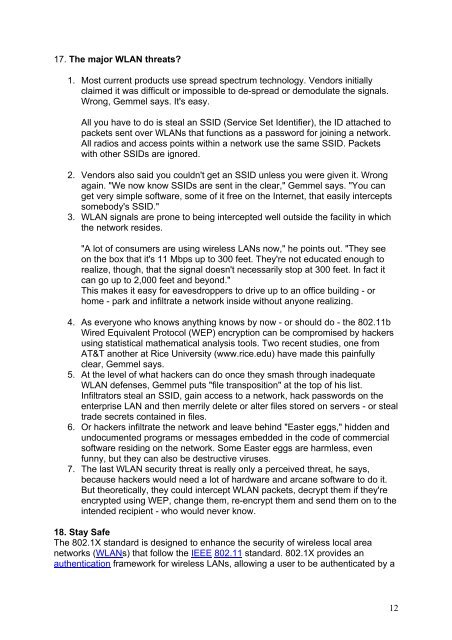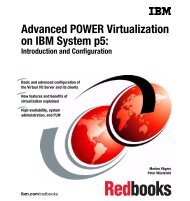Wireless LAN
Wireless LAN
Wireless LAN
Create successful ePaper yourself
Turn your PDF publications into a flip-book with our unique Google optimized e-Paper software.
17. The major W<strong>LAN</strong> threats?<br />
1. Most current products use spread spectrum technology. Vendors initially<br />
claimed it was difficult or impossible to de-spread or demodulate the signals.<br />
Wrong, Gemmel says. It's easy.<br />
All you have to do is steal an SSID (Service Set Identifier), the ID attached to<br />
packets sent over W<strong>LAN</strong>s that functions as a password for joining a network.<br />
All radios and access points within a network use the same SSID. Packets<br />
with other SSIDs are ignored.<br />
2. Vendors also said you couldn't get an SSID unless you were given it. Wrong<br />
again. "We now know SSIDs are sent in the clear," Gemmel says. "You can<br />
get very simple software, some of it free on the Internet, that easily intercepts<br />
somebody's SSID."<br />
3. W<strong>LAN</strong> signals are prone to being intercepted well outside the facility in which<br />
the network resides.<br />
"A lot of consumers are using wireless <strong>LAN</strong>s now," he points out. "They see<br />
on the box that it's 11 Mbps up to 300 feet. They're not educated enough to<br />
realize, though, that the signal doesn't necessarily stop at 300 feet. In fact it<br />
can go up to 2,000 feet and beyond."<br />
This makes it easy for eavesdroppers to drive up to an office building - or<br />
home - park and infiltrate a network inside without anyone realizing.<br />
4. As everyone who knows anything knows by now - or should do - the 802.11b<br />
Wired Equivalent Protocol (WEP) encryption can be compromised by hackers<br />
using statistical mathematical analysis tools. Two recent studies, one from<br />
AT&T another at Rice University (www.rice.edu) have made this painfully<br />
clear, Gemmel says.<br />
5. At the level of what hackers can do once they smash through inadequate<br />
W<strong>LAN</strong> defenses, Gemmel puts "file transposition" at the top of his list.<br />
Infiltrators steal an SSID, gain access to a network, hack passwords on the<br />
enterprise <strong>LAN</strong> and then merrily delete or alter files stored on servers - or steal<br />
trade secrets contained in files.<br />
6. Or hackers infiltrate the network and leave behind "Easter eggs," hidden and<br />
undocumented programs or messages embedded in the code of commercial<br />
software residing on the network. Some Easter eggs are harmless, even<br />
funny, but they can also be destructive viruses.<br />
7. The last W<strong>LAN</strong> security threat is really only a perceived threat, he says,<br />
because hackers would need a lot of hardware and arcane software to do it.<br />
But theoretically, they could intercept W<strong>LAN</strong> packets, decrypt them if they're<br />
encrypted using WEP, change them, re-encrypt them and send them on to the<br />
intended recipient - who would never know.<br />
18. Stay Safe<br />
The 802.1X standard is designed to enhance the security of wireless local area<br />
networks (W<strong>LAN</strong>s) that follow the IEEE 802.11 standard. 802.1X provides an<br />
authentication framework for wireless <strong>LAN</strong>s, allowing a user to be authenticated by a<br />
12
















